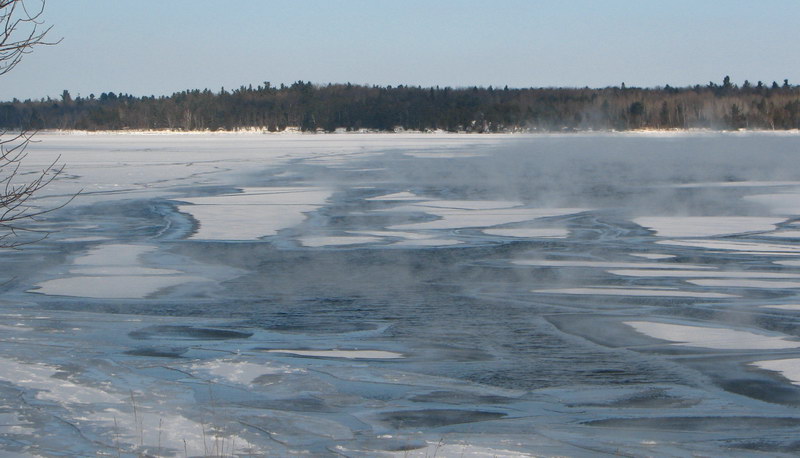Off-Edge, Cold Wind Driven Breakup of an Ice Sheet
Summary: Wind blowing off an ice edge may seem like it will not do much damage to an ice sheet, however cracks in the ice sheet or under ice melting can cause a lot ice sheet loss in a few hours, even in fairly light winds.
A number of years ago we had a cold snap that put a couple inches of black ice on Town Farm Bay in Charlotte VT. The bay opens to the south into one of the deepest parts of Lake Champlain. With very cold temperatures and a light north wind over the following night we expected another inch or more of additional ice with no worries about waves breaking up the ice. We showed up the next morning to find the ice was gone!
While this was counter intuitive at first, we figured out that the north wind was pulling the surface water away from the south facing ice edge. This pulled up warmer water from deeper underneath the ice as shown in the following diagram. It is also possible that most of the ice loss resulted from waves refracting around Thompson's point just to the west of Town Farm Bay. These deminished waves could have wave-cracked the thin ice sheet near its edge, cutting loose the pieces to be blown downwind into the open water.
A friend, Dr Barney Kenny, has studied underice currents. He describes this as a conveyer belt current. This is one of a couple of mechanisms that could have accounted for the ice loss in the two situations described in this article.
In late January 2011 we had another windy cold snap with 24 hrs of overnight and daytime temperatures a bit below zero and winds from the North at 15-20 mph. While checking ice a little south of Plattsburgh NY we found a similar situation. In this case a roughly 4 inch ice sheet formed overnight between Valcour Island and the shore. When we were there, pieces were being pulled away from the south edge of the sheet.
The blue lines are the ice edge, The blue place mark is on the ice sheet. The yellow place mark is the vantage point of the following pictures.
 The disintegrating ice edge looking north east toward Valcour Island. The wind is from the north at about 15 and the temp is around zero.
The disintegrating ice edge looking north east toward Valcour Island. The wind is from the north at about 15 and the temp is around zero.
 Closer shot of the ice edge. Based on our limited experience with this, it appears to be more a problem with thinner ice. Contraction cracks and, perhaps more importantly, wave-break cracks that form in the intact part of the ice sheet probably assist the break up process. Waves in long-fetch open water can easily refract around land to roll in at diminished size in directions that are quite far from the wind direction. Temperature measurements made at ice edges with an off shore wind in shallow water (see Slushball article) showed a water temperature of around 33 deg, not a lot of energy for significant underice melting. In other circumstances higher water temperatures have been found. More work needs to be done to sort out which mechanisms are important however for the ice traveler, the outcome is the same: an off edge wind can remove a lot of ice from an ice sheet fairly quickly. Occasionally someone gets an unintended ride on a liberaged ice flow.
Closer shot of the ice edge. Based on our limited experience with this, it appears to be more a problem with thinner ice. Contraction cracks and, perhaps more importantly, wave-break cracks that form in the intact part of the ice sheet probably assist the break up process. Waves in long-fetch open water can easily refract around land to roll in at diminished size in directions that are quite far from the wind direction. Temperature measurements made at ice edges with an off shore wind in shallow water (see Slushball article) showed a water temperature of around 33 deg, not a lot of energy for significant underice melting. In other circumstances higher water temperatures have been found. More work needs to be done to sort out which mechanisms are important however for the ice traveler, the outcome is the same: an off edge wind can remove a lot of ice from an ice sheet fairly quickly. Occasionally someone gets an unintended ride on a liberaged ice flow.
The ice sometimes departs in a wholesale fashion, especially if it is not well constrained at the sides or if the ice sheet is really big. This usually occurs at a near shore crack or transition between thicker shorefast ice and a newer ice sheet. Lake Eire has events like this regularly as does Lake Vattern in Sweden.
Moderate wind blowing at an ice edge generally does much less damaged to the ice sheet than off edge wind. The waves break and crack the ice near the edge in a specific sequence running from small loose pieces to pancakes to wave cracked plates. Of course if the wind is very strong and there is a long fetch to build up big waves they can do a lot of damage to an ice sheet, especially in thaw conditions. Also, large ice flows detached from an upwind ice edge can do significant damage when they collide with a downwind sheet. We believe this accounts for a lot of the jumbled ice (see glossary) seen on big ice.
Bob
Revised 1/17/12
